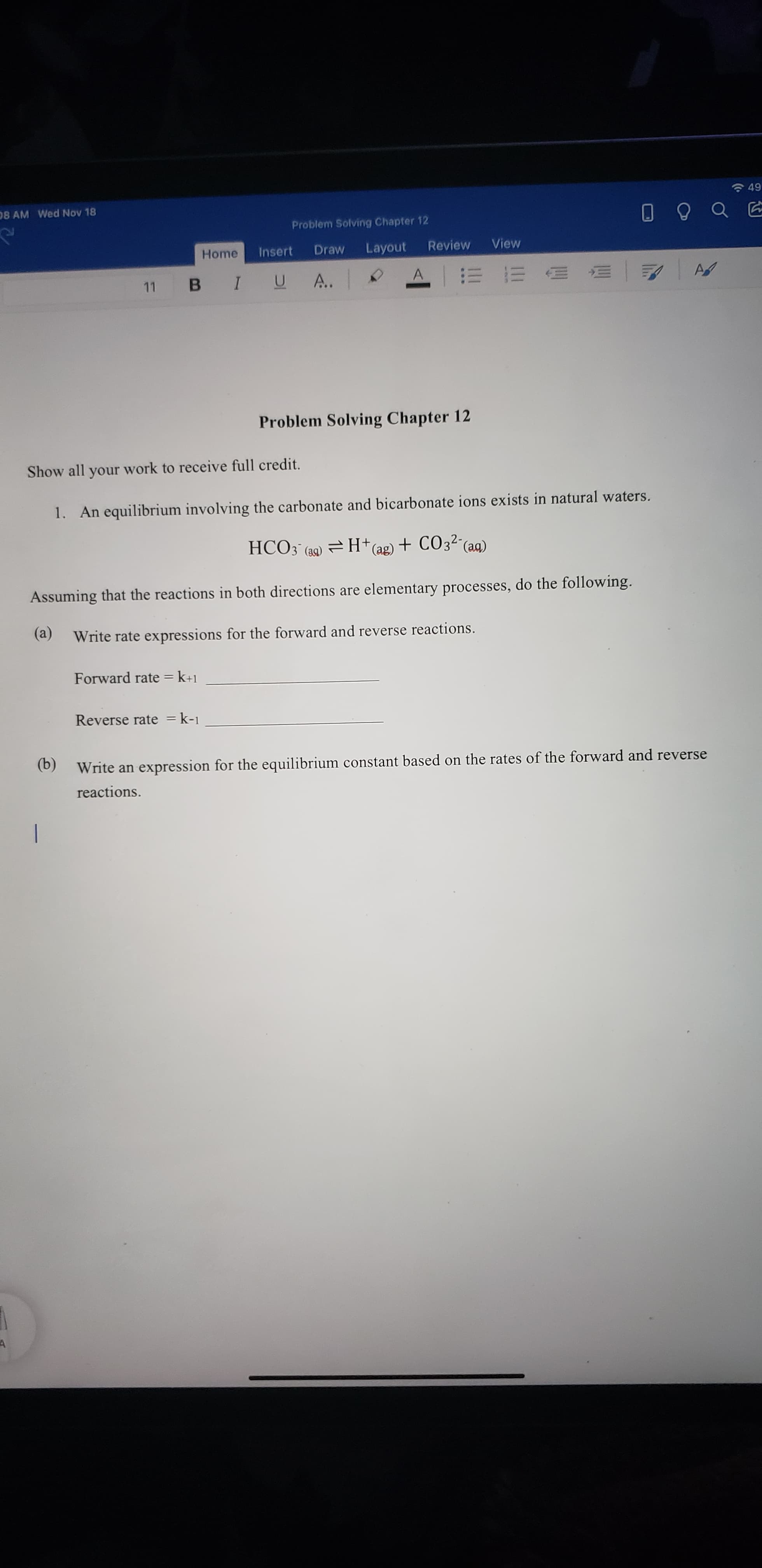Show all your work to receive full credit. 1. An equilibrium involving the carbonate and bicarbonate ions exists in natural waters. HCO3 (a9) = H†(ag) + CO3²¯(ag) Assuming that the reactions in both directions are elementary processes, do the following. (a) Write rate expressions for the forward and reverse reactions. Forward rate = k+1 %3D Reverse rate = k-1 (b) (b) Write an expression for the equilibrium constant based on the rates of the forward and reverse reactions.
Show all your work to receive full credit. 1. An equilibrium involving the carbonate and bicarbonate ions exists in natural waters. HCO3 (a9) = H†(ag) + CO3²¯(ag) Assuming that the reactions in both directions are elementary processes, do the following. (a) Write rate expressions for the forward and reverse reactions. Forward rate = k+1 %3D Reverse rate = k-1 (b) (b) Write an expression for the equilibrium constant based on the rates of the forward and reverse reactions.
Introductory Chemistry: An Active Learning Approach
6th Edition
ISBN:9781305079250
Author:Mark S. Cracolice, Ed Peters
Publisher:Mark S. Cracolice, Ed Peters
Chapter18: Chemical Equilibrium
Section: Chapter Questions
Problem 14E
Related questions
Question
100%
An equilibrium involving the carbonate and bicarbonate ions exist in natural waters.
HCO3-(aq) -> H+(ag) + CO32-(aq)
Assuming that the reactions in both directions are elementary processes, do the following write rate expressions for the forward and reverse reactions.


Transcribed Image Text:Show all your work to receive full credit.
1. An equilibrium involving the carbonate and bicarbonate ions exists in natural waters.
HCO3 (a9) = H†(ag) + CO3²¯(ag)
Assuming that the reactions in both directions are elementary processes, do the following.
(a)
Write rate expressions for the forward and reverse reactions.
Forward rate = k+1
%3D
Reverse rate = k-1
(b)
(b) Write an expression for the equilibrium constant based on the rates of the forward and reverse
reactions.
Expert Solution
This question has been solved!
Explore an expertly crafted, step-by-step solution for a thorough understanding of key concepts.
This is a popular solution!
Trending now
This is a popular solution!
Step by step
Solved in 2 steps with 1 images

Knowledge Booster
Learn more about
Need a deep-dive on the concept behind this application? Look no further. Learn more about this topic, chemistry and related others by exploring similar questions and additional content below.Recommended textbooks for you

Introductory Chemistry: An Active Learning Approa…
Chemistry
ISBN:
9781305079250
Author:
Mark S. Cracolice, Ed Peters
Publisher:
Cengage Learning

Introduction to General, Organic and Biochemistry
Chemistry
ISBN:
9781285869759
Author:
Frederick A. Bettelheim, William H. Brown, Mary K. Campbell, Shawn O. Farrell, Omar Torres
Publisher:
Cengage Learning


Introductory Chemistry: An Active Learning Approa…
Chemistry
ISBN:
9781305079250
Author:
Mark S. Cracolice, Ed Peters
Publisher:
Cengage Learning

Introduction to General, Organic and Biochemistry
Chemistry
ISBN:
9781285869759
Author:
Frederick A. Bettelheim, William H. Brown, Mary K. Campbell, Shawn O. Farrell, Omar Torres
Publisher:
Cengage Learning


Chemistry: Principles and Practice
Chemistry
ISBN:
9780534420123
Author:
Daniel L. Reger, Scott R. Goode, David W. Ball, Edward Mercer
Publisher:
Cengage Learning

Introductory Chemistry: A Foundation
Chemistry
ISBN:
9781337399425
Author:
Steven S. Zumdahl, Donald J. DeCoste
Publisher:
Cengage Learning

Chemistry: The Molecular Science
Chemistry
ISBN:
9781285199047
Author:
John W. Moore, Conrad L. Stanitski
Publisher:
Cengage Learning